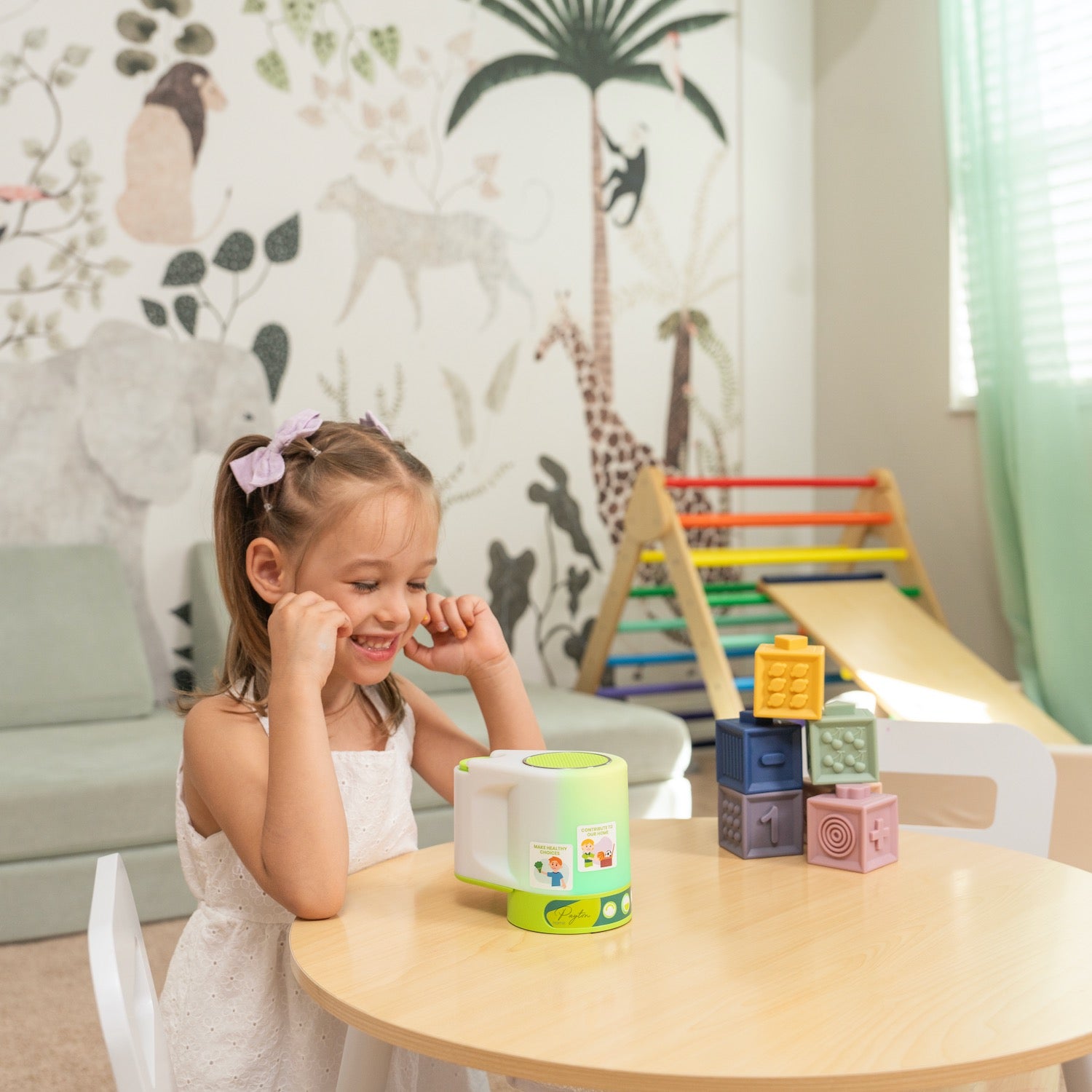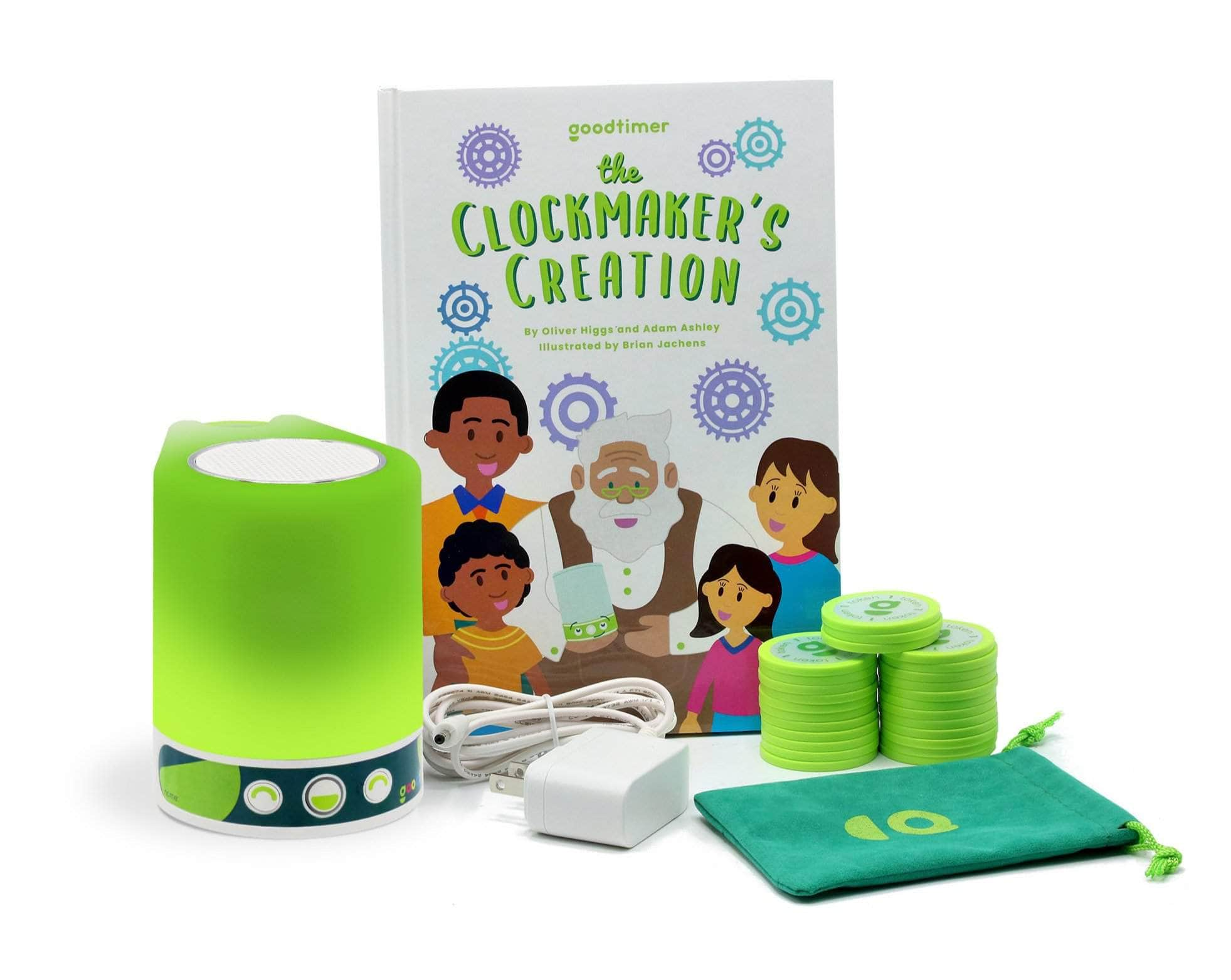As the clock ticks closer to bedtime, do you find yourself mustering up courage as if you’re preparing to go to battle? Will your future war be waged against your cranky child while helping them get ready for bed?
You are not alone. Getting kids ready for bed has challenged great parents for centuries. But before reaching for that bottle of melatonin for kids, try these tips alongside an educational/behavioral management tool like Goodtimer to help you and your child take control of their nighttime routine.
Experts agree that creating a bedtime routine helps your kids go to sleep earlier, fall asleep faster, and improve sleep quality for longer periods of time. Creating a routine not only helps your child’s current growth, but it sets them up for healthy habits in their teenage and adult years as well. Plus, as we will discuss, it can become a built-in opportunity to bond with your child.
Goodtimer not only supports your child’s nighttime routine, but turns bedtime into a fun and rewarding experience through the use of positive reinforcement. Goodtimer’s colorful glow encourages your kiddo to stay on track and inspires them with the promise of a meaningful incentive.
Winding down for the night can be especially challenging when your child has extra difficulties like ADHD. The truth is, each and every energetic child finds it difficult to recognize when they’re low on energy. They need your guidance to set them up for a successful nights’ sleep so they can blast out of bed the next day, ready for new adventures!
Research shows that it only takes a couple of nights for a new bedtime routine to start having positive results, so...let’s get started today!
What Time Should My Child Go to Bed?
The American Academy of Sleep Medicine does not suggest specific bedtimes for our kids; rather, they recommend the quantity of hours children should be sleeping per day based on their age group. The best way to figure out your child’s ideal bedtime would then be to: a) establish at what time your child/family wakes up in the mornings, and then b) count backwards from that time to ensure sufficient hours slept for your little one. Hourly recommendations are as follows:
|
Toddlers (1 to 2 years old) |
11-14 hours (including naps) |
|
Children (3 to 5 years old) |
10-13 hours (including naps) |
|
Children (6-12 years) |
9-12 hours |
So, for example, if you have a 3-year-old who wakes up at 6am every morning and does not nap, their ideal bedtime would theoretically fall between 5pm-8pm.
Reminder: every family is different! Depending on your family’s unique challenges, you may find it difficult to fall within these guidelines each and every night. Try to be gentle with yourself and do your best.
Creating a Nighttime Routine
Effective nighttime routines spring into action long before a child's actual bedtime; start early and leave yourself time to help set your child (and you) up for success.
Set the Tone
Think back to the last time your child resisted their bedtime routine - likely not fun. Next time, instead of preparing for a confrontation that feels anything but calming, try to envision a wind-down routine that connects you to your child while also serving their needs. These days many parents work long hours and finding quality time to spend with our kids can be difficult. Even if (especially if!) you feel completely depleted at the end of the day, try to reframe your kids' bedtime as an opportunity for joy, connection, and mutual relaxation (more tips on this below) as opposed to a battlefield.
Make a Plan With Your Kids
During the day when bedtime seems impossibly far away, try to explain the power of sleep to your children in a way that speaks to them specifically. Are they working on getting across the monkey bars? Are they passionate about creating artwork with their new box of crayons? Do they come alive on the soccer field? Tell them that sleep can support the goals and values that are important to them. While they may be too young to understand circadian rhythms, they can likely find inspiration to get into bed at night once they understand the importance of sleep in their lives.
When they are sold on the importance of sleep, talk to your child about the bedtime tasks you expect them to do - and how you expect them to be done - as part of their “getting ready for bed” routine. Remind them how their Goodtimer will glow as they make good choices and read A Clockmaker’s Creation together to bring the point home. Ask them what prizes they’d like to receive for sticking to their new bedtime routine, and then solidify goals and incentives together. Lastly, identify which behaviors will not be tolerated and remind them that not adhering to the new bedtime routine will result in negative consequences (e.g., they will have to flip their Goodtimer and forfeit any predetermined reinforcers for that evening).
Empower Kids to be the Bosses of their Bedtimes
Once your expectations for bedtime have been made clear, the fun can begin as you empower your child to be the boss of their own bedtime! Remember - kids are very rarely in charge of their own choices. Utilizing a tool called “choice theory” is an effective way to make your kids feel some authority over their behavior and pride over their choices. All it entails is giving your child a choice between options as opposed to only ever giving them pointed instructions. It is especially effective if you sense your child is beginning to become disregulated and/or resist the bedtime routine. For example, instead of telling them what to do next, or raising your voice to tell them to get into their pajamas for the sixth time, try asking them whether they'd like to wear the red pajamas or the yellow pajamas; ask them which lullaby they feel like singing with you because you can't decide between "A Whole New World" and the one your grandmother used to sing; ask them if they want a funny book or a calming book.
Parenting champions like Brene Brown use this parenting technique because it helps kids develop a sense of responsibility over their own lives. Brown gives readers an example of a time when her young son began to toss his dinner onto the floor. She said, “Charlie, you have two choices: you can leave your peas on your tray, or you can be done eating. Which do you choose?” Note: she did not include “toss your dinner onto the floor” as an option, however when her son continued to do so, she treated the situation as if he had chosen to "be done eating" and collected his plate - dinner was over.
With choice theory in your back pocket for some of the more challenging moments, you are ready to begin! Before bedtime routine kicks off, make sure your child’s Goodtimer is nearby and announce with some authority that it is time to get started on the new bedtime routine! Remember, this “new” routine which you developed together with your child is meant to involve smiles, snuggles, and feelings of “I can.” Be sure to clarify your own intentions prior to each bedtime routine implementation to preserve the themes that connect to your values.
Bedtime Routine Ideas - Needs vs. Extras:
Step 1: Turn Goodtimer right side up and clarify plans/expectations - use choice theory to respond to resistance.
Step 2: NEEDS - these are the elements of the routine that speak to our children’s hygiene and wellbeing in that they are not optional. These tasks are ideal to reinforce with Goodtimer!
- Take a bath
- Put on pajamas
- Brush teeth
- Go to the potty and/or put on a nighttime diaper
Step 3: EXTRAS - these need not be reinforced via Goodtimer because they are reinforcing in themselves! EXTRAS are optional, and by no means should you (or could you!) include all of the following ideas in your routine; that said, they speak to the aforementioned concept of bedtime being framed as an opportunity for connection between you and your child. If you have the capacity, attempt to choose between 1-3 that work for you and your family. You can even switch off from night to night.
- Have a healthy snack
- Brush teeth
- Say a bedtime prayer
- Read a story
- Sing a song
- Discuss the day’s events
- Have a cuddle
- Listen to calming music
After closing with a hug and kiss, leave the room while your child is feeling sleepy but still awake. This enables them to wake in the middle of the night without feeling startled by loneliness, and gives them confidence in their ability to fall asleep on their own.
Do this Not That! Bedtime Routine Edition
Follow this simple checklist to help bedtime become everyone’s favorite part of the day.
Do:
- Create an exciting Goodtimer token incentive. Depending on your child’s age and ability to wind down, they could work toward gathering a week’s worth of tokens to cash them in for something wonderful.
- Calm the house and dim the lights to help eliminate distractions outside of your child’s room. Inside their room, keep things cool, dark, and quiet, and consider adding a white noise machine.
- Be consistent. Once you understand which steps best support your child’s ability to wind down for the night, stick with it. A routine, when done consistently, will trigger a sense of sleepiness in your child.
- Keep multiple caregivers informed: if you are not the only one putting your child to bed, make sure everyone in your village - partners, babysitters, grandparents, etc. - is on the same page regarding their bedtime routine.
- Bring joy into the routine - for you and your child!
- Request a Goodtimer “flip,” whenever needed. When your child crosses a line, ask them to flip their Goodtimer to visually reinforce the boundary line that you set.
- Identify hurdles. Young kids find it challenging to vocalize their feelings, so you'll have to watch for cues (an itchy tag could make anyone irritable!) as well as listen to their verbal feedback.
- Give them a transitional object. Being alone can feel scary, but a stuffy or favorite blanket can support your child’s ability to self-soothe.
- Watch the clock. Aim for a half hour to keep the routine concise and on track
Don’t:
- Host a sock-footed dance party. As fun as that sounds, limit the cardio when bedtime is near and switch to calming activities, like coloring, instead
- Be flexible on your Goodtimer boundaries. Testing boundaries is a positive part of your child’s development, and it’s a parents’ job to hold up the standards we create.
- Give screens during the hour before lights out. Research proves that the blue light from televisions, phones, and tablets can make it harder to fall asleep.
- Start the routine when it’s too late. If they’re already tired, their grouchy behavior will come out as resistance to the routine.
- Hand out dessert as the before-bed snack. We all know the results of sugar on our kids' behavior!
- Alter the schedule for weekends. As much as you are able to, maintain the same bedtime and wake time over the weekends as you instill on weekdays (even when there’s a break in the schedule) to support your child’s circadian rhythm.
By using the right tools and advice, winding down for bedtime can be a fun, skill-building, and rewarding experience. It gives parents a designed window for quality time with their children while supporting and encouraging healthy sleep habits. Use your Goodtimer to assist in transforming nightly struggles into opportunities for your child to develop essential life skills. Your child will love the positive encouragement from their Goodtimer, and you will love the improvements in their behavior - a win-win. Encourage your child to stay on track during their bedtime routine with Goodtimer.
For additional information, take a look at Dr. Richard Ferber's Solve Your Child's Sleep Problems and post your bedtime dilemmas and solutions in The Goodtimer Village group.
Watch the Video:
Backlinks included: https://www.additudemag.com/adhd-sleep-problems/, https://pubmed.ncbi.nlm.nih.gov/28985580/ https://pubmed.ncbi.nlm.nih.gov/21517173/ https://gogoodtimer.com/collections/staff-picks https://www.sleepfoundation.org/children-and-sleep/how-much-sleep-do-kids-need










Leave a comment